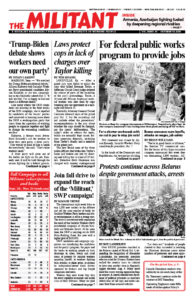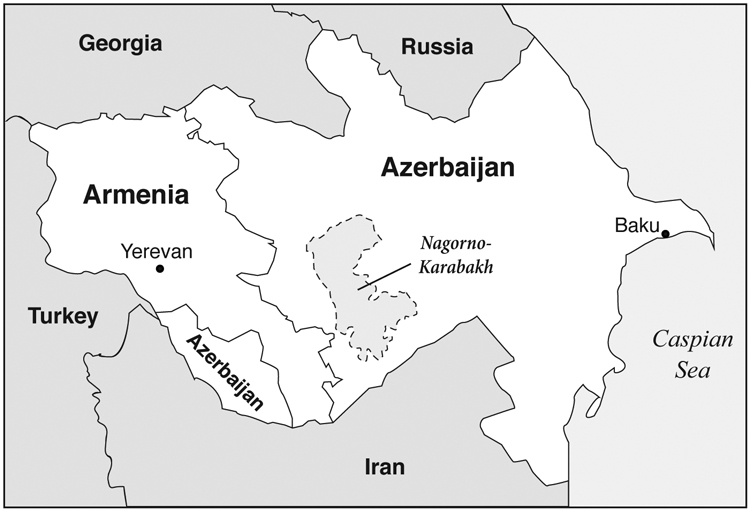Bloody clashes have broken out in the Caucasus as the regimes in Azerbaijan and Armenia are battling over control of the territory of Nagorno-Karabakh. Their decadeslong dispute over the area is stoked by the rulers of Russia and Turkey, who seek to control the oil resources and markets of the region.
The governments of Armenia and Azerbaijan have accused one another of firing into each other’s territory since Sept. 29. Nagorno-Karabakh lies within Azerbaijan, but has a majority-Armenian population. At least 158 people have been killed.
Some 30,000 were slaughtered in a war over control of the territory fought out in the course of the disintegration of the Stalinist regime in the Soviet Union in 1991. An armistice was brokered by the new government in Russia in 1994, but no peace treaty has ever been signed. Hundreds of thousands of Azeris were driven out of Nagorno-Karabakh and today it is administered by forces linked to the Armenian government. The rulers of Azerbaijan continued to insist the enclave is theirs, and repeatedly threaten to seize it.
Moscow has close ties with both countries — which are former Soviet republics — and considers the Caucasus to be part of its “near abroad” — its sphere of domination. The Turkish rulers are allies of the Azerbaijan government, and insist it is their duty to defend their fellow Turkic people.
Moscow has directly intervened in the region, and in other parts of its “near abroad,” like Crimea, when the Russian rulers felt their interests were threatened. They invaded Georgia in 2008, tightening Moscow’s grip on the region.
Turkish President Recep Tayyip Erdogan accuses the government of Armenia of being “the greatest threat to peace and tranquility in the region,” while supplying weapons to the rulers in Azerbaijan.
Azeris are among the mostly Moslem Turkic-speaking people who live in countries across Central Asia. What today is Azerbaijan was conquered by the Russian Czarist Empire in the 18th century. Before the end of the first imperialist world war, the rulers of the Ottoman Empire in what is now Turkey invaded the area and tried to conquer the region.
Armenians are a centuries-old nationality and mostly Christian. Their land — and their national monument, the historic Mount Ararat — was conquered by the Ottoman Empire in the 16th century, and by Russia in the 19th. In 1915 the Ottoman rulers carried out a bloody massacre of hundreds of thousands of Armenians.
Revolution changes Caucasus
With the end of World War I, the fall of the Ottoman Empire, and the workers and farmers revolution in Russia, workers and peasants in both Armenia and Azerbaijan rose up and took power.
The Soviet governments established there, as well as in Georgia, Ukraine and Belarus, joined Russia to establish the Union of Soviet Socialist Republics. The revolutionary government in Russia, led by V.I. Lenin and the Bolsheviks, fought to guarantee the rights of nations long oppressed by the former Czarist Empire, and took special steps to aid the development of the economy, language rights and culture of the oppressed peoples in the USSR. There was a flowering of literacy and art in both Azerbaijan and Armenia, and, along with Georgia, they united in a common Transcaucasian Socialist Federative Soviet Republic.
But the Bolsheviks’ revolutionary policy on national self-determination and voluntary federation came under attack by an emerging bureaucratic layer led by Joseph Stalin in the 1920s. Before his death in 1924, Lenin’s last political battle was against Stalin’s efforts to reimpose Great Russian chauvinism in Georgia.
The gains made by workers and farmers in the Transcaucasus were reversed by the counterrevolution engineered by Stalinism. And national rivalries that had begun to recede reemerged. Today’s bloody conflicts are one consequence of that defeat.
In the immediate years after the breakup of the Soviet Union, the emerging capitalist rulers in both Azerbaijan and Armenia declared their independence.
In Azerbaijan, the rulers enriched themselves and foreign capitalist investors by expanding their exploitation of the country’s vast oil and gas resources. They have routed new pipelines through Georgia and Turkey, largely avoiding Moscow’s pipeline network, to sell fuel in Western Europe. A pipeline from Azerbaijan’s Caspian Sea shoreline opened last November, running near Nagorno-Karabakh.
Moscow’s ties are closest to the rulers of Armenia, where it maintains a military base and deploys 5,000 troops along the country’s border with Turkey.
Growing capitalist crisis
As the crisis of capitalism deepens worldwide, regimes like Moscow and Ankara are driven to heightened competition for economic exploitation and political sway. Moscow accuses Erdogan of sending mercenary forces he arms from Syria to reinforce Azerbaijani troops.
The rulers of Russia and Turkey have also faced each other in their interventions on opposing sides of civil wars in Libya and Syria. And the Turkish government is involved in territorial conflicts with the governments of Greece, Israel, Italy and Egypt over which of them will profit from the development of recently discovered gas fields in the eastern Mediterranean.
Erdogan on Oct. 3 claimed Turkey would “take its deserved place in the global world order,” as a result of his government’s interventions. In reality the country’s ruling capitalist families operate from mounting weakness today, driven by a spiraling economic crisis at home.
Their currency, the lira, has plummeted 150% against the dollar since 2016. Credit-rating agencies have downgraded the sovereign debt of Turkey and foreign capitalists are fleeing from investments there.
For working people the Erdogan regime has been a disaster. The twin scourges of unemployment and inflation have both risen into double digits in recent months. Over a quarter of all young people have no work, while the number who have given up hope of finding work altogether is at a record high — three times the level it was last year.
Moscow has its own problems, with an economy over-reliant on oil, a popular uprising in neighboring Belarus, and monthslong sizable protests in Russia’s Far East.


